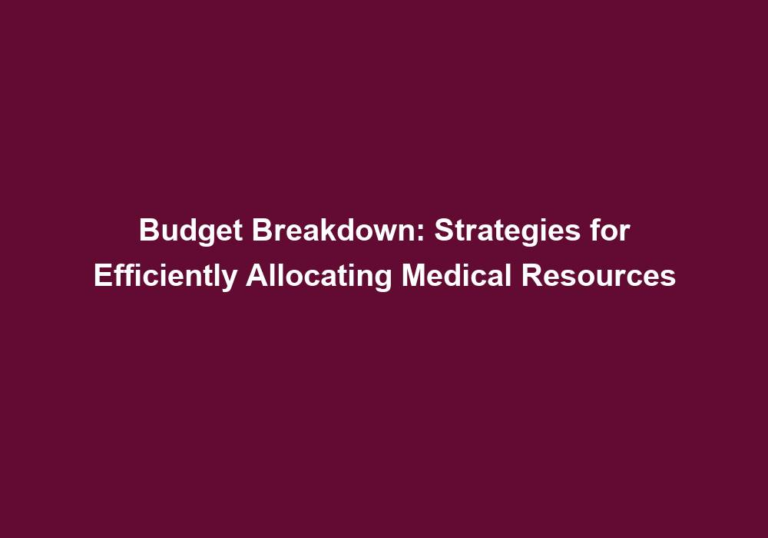Clinic Crystal Ball: Predicting and Preparing for Financial Trends in Healthcare
With the ever-evolving landscape of the healthcare industry, it is crucial for clinics to stay ahead of the game when it comes to predicting and preparing for financial trends. By understanding and adapting to these trends, clinics can ensure their long-term survival and success. In this article, we will explore some key financial trends in healthcare and discuss strategies that clinics can implement to navigate these changes effectively.
The Rise of Value-Based Care
One of the most significant financial trends in healthcare is the shift towards value-based care. This approach focuses on improving patient outcomes while reducing the overall cost of care. As clinics transition from the traditional fee-for-service model to value-based care, it is essential to understand the financial implications.
Clinics can embrace value-based care by implementing strategies such as:
-
Care Coordination: Strengthening communication and collaboration among healthcare providers to ensure seamless and efficient care delivery. This can include implementing electronic health records (EHRs) that allow for easy sharing of patient information among providers, as well as utilizing care teams to coordinate patient care plans.
-
Patient Engagement: Actively involving patients in their care through education, shared decision-making, and self-management tools. This can include providing patients with access to their own health information through patient portals, offering educational resources to empower patients to make informed decisions about their health, and utilizing remote monitoring technologies to keep patients engaged in their care.
-
Data Analytics: Utilizing advanced analytics to identify patterns, predict outcomes, and drive continuous improvement in patient care. This can include analyzing data from EHRs and other sources to identify opportunities for quality improvement, implementing predictive analytics tools to forecast patient needs and resource utilization, and leveraging data to support evidence-based decision-making.
-
Risk Management: Identifying and managing potential risks to optimize financial performance while delivering high-quality care. This can include conducting regular risk assessments to identify areas of vulnerability, implementing strategies to mitigate identified risks, and monitoring key performance indicators to ensure ongoing risk management.
By embracing these strategies, clinics can position themselves as leaders in value-based care, improving patient outcomes while maintaining financial stability.
The Role of Technology in Healthcare Financial Trends
Technology continues to revolutionize the healthcare industry, and its impact on financial trends cannot be overlooked. From electronic health records (EHRs) to telehealth services, technology offers clinics numerous opportunities to streamline operations, improve patient care, and reduce costs.
Here are some technology-driven financial trends that clinics should consider:
-
Telehealth: Telehealth services allow clinics to provide virtual consultations and remote monitoring, reducing the need for in-person visits and associated costs. By leveraging telehealth platforms, clinics can expand access to care, reach patients in remote areas, and reduce transportation expenses for both patients and providers.
-
EHRs and Revenue Cycle Management: Implementing robust EHR systems can simplify billing, coding, and claims management processes, improving revenue cycle efficiency. By automating administrative tasks, clinics can reduce errors and delays in the billing process, accelerate reimbursement, and minimize the need for manual intervention.
-
Data Security and Privacy: As clinics increasingly rely on technology, ensuring the security and privacy of patient health information is paramount to avoid costly breaches and penalties. Implementing robust security measures, such as encryption and access controls, can safeguard patient data and protect clinics from potential financial and reputational damage.
By leveraging technology effectively, clinics can enhance operational efficiency, improve patient satisfaction, and maximize financial performance.
Healthcare Policy and Reimbursement Changes
Healthcare policies and reimbursement models continually evolve, and clinics must stay informed and adapt accordingly. Understanding current policies and anticipating future changes can help clinics navigate financial trends and ensure optimal reimbursement.
Some key policy and reimbursement changes to consider:
-
Medicare and Medicaid Reimbursement: Tracking changes in Medicare and Medicaid reimbursement rates and policies can help clinics anticipate revenue fluctuations and adjust their financial strategies accordingly. By staying up-to-date with reimbursement guidelines, clinics can optimize billing and coding practices to maximize reimbursement while ensuring compliance.
-
Alternative Payment Models (APMs): Familiarizing yourself with APMs, such as accountable care organizations (ACOs) and bundled payments, can help clinics align their care delivery and financial models with these evolving reimbursement frameworks. By participating in APMs, clinics can share in cost savings and achieve financial incentives for delivering high-quality, coordinated care.
-
Health Insurance Marketplace: Keeping up-to-date with changes in health insurance marketplace regulations can help clinics optimize contract negotiations and ensure fair reimbursement. By understanding coverage requirements and reimbursement rates, clinics can negotiate favorable contracts with insurance providers and minimize financial risks.
By actively monitoring policy changes and adapting their financial strategies, clinics can mitigate potential risks and seize new opportunities.
The Importance of Strategic Partnerships
Collaboration and strategic partnerships play a vital role in navigating financial trends in the healthcare industry. By forging alliances with other healthcare providers, clinics can pool resources, share expertise, and access new patient populations.
Some potential strategic partnerships for clinics include:
-
Hospitals and Specialty Centers: Collaborating with hospitals and specialty centers can lead to referral networks, shared infrastructure, and coordinated care, ultimately enhancing financial stability. By establishing relationships with these entities, clinics can expand their patient base, improve care coordination, and optimize resource utilization.
-
Pharmaceutical Companies and Medical Device Manufacturers: Partnering with pharmaceutical companies and medical device manufacturers can provide access to the latest treatments, research opportunities, and potential revenue streams. By participating in clinical trials or offering specialized services, clinics can generate additional income and contribute to medical advancements.
-
Community Organizations and Nonprofits: Building relationships with community organizations and nonprofits can help clinics tap into funding sources, grants, and community outreach programs. By collaborating with these entities, clinics can secure financial support for initiatives that improve access to care, address social determinants of health, and enhance community engagement.
Strategic partnerships can provide clinics with a competitive edge, increase their financial viability, and improve patient care.
Monitoring Financial Performance and Analytics
Lastly, clinics must consistently monitor their financial performance and leverage analytics to gain insights into their operations. By analyzing key financial metrics, clinics can identify trends, track performance, and make data-driven decisions to optimize their financial outcomes.
Some essential financial metrics for clinics to monitor include:
-
Revenue and Expenses: Tracking revenue streams and expenses allows clinics to identify areas of profitability and areas that may require cost reduction. By monitoring revenue sources and cost drivers, clinics can make informed decisions about resource allocation and identify opportunities for financial improvement.
-
Accounts Receivable: Monitoring accounts receivable aging and implementing effective collection strategies can improve cash flow and reduce bad debt. By proactively managing accounts receivable, clinics can accelerate revenue collection, minimize write-offs, and maintain a healthy financial position.
-
Operational Efficiency: Analyzing productivity metrics, such as patient wait times and appointment utilization rates, can help clinics identify bottlenecks and improve operational efficiency. By optimizing workflows, reducing wait times, and maximizing appointment utilization, clinics can enhance patient satisfaction, increase capacity, and improve financial performance.
By leveraging financial analytics, clinics can proactively identify areas for improvement, optimize revenue generation, and ensure financial sustainability.
In conclusion, clinics must stay proactive in predicting and preparing for financial trends in healthcare. By embracing value-based care, leveraging technology, adapting to policy changes, forging strategic partnerships, and monitoring financial performance, clinics can navigate these trends successfully. By doing so, clinics can ensure their long-term financial stability while providing high-quality care to their patients.







